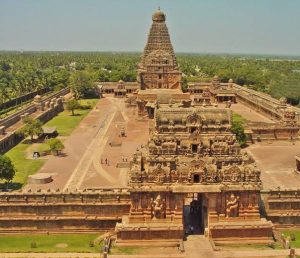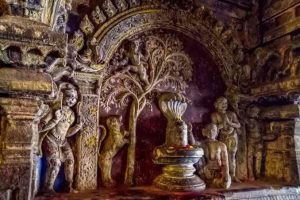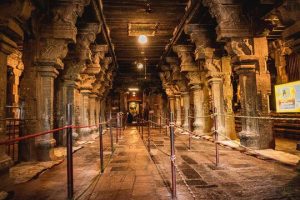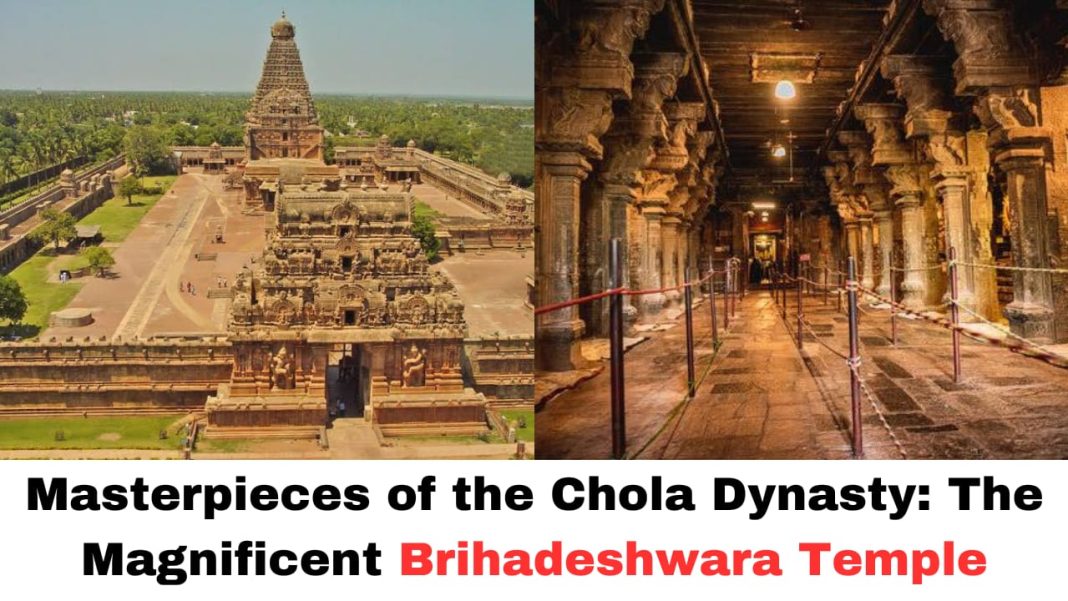Digital News Guru Tamil Nadu Desk:
The Brihadeshwara Temple: The Heart of the Chola Empire’s Religious Legacy
The Brihadeshwara Temple, also known as the Peruvudaiyar Kovil or Rajarajeswaram, is one of the most remarkable architectural and cultural landmarks of India. Located in Thanjavur, Tamil Nadu, this ancient Hindu temple is dedicated to Lord Shiva and is an exemplar of Dravidian architecture. Constructed during the reign of the Chola dynasty, it stands as a testimony to the grandeur, artistry, and ingenuity of South Indian architecture, drawing visitors and scholars from all over the world. It is a UNESCO World Heritage Site, belonging to the “Great Living Chola Temples” group, which also includes the temples at Gangaikonda Cholapuram and Airavatesvara.
Historical Context
The Brihadeshwara Temple was built by the great Chola king, Raja Raja Chola I, who ascended the throne in 985 CE. His reign is considered one of the golden eras of Tamil history, marked by territorial expansion, cultural renaissance, and significant contributions to architecture and religion. The temple was completed in 1010 CE and was dedicated to Lord Shiva, one of the principal deities in Hinduism. It symbolizes the king’s devotion to the god and his desire to build a magnificent structure that could serve both as a center of worship and a symbol of the Chola empire’s power.

The Cholas, known for their expertise in temple building, created a distinct style that is still admired for its complexity and grandeur. Raja Raja Chola’s decision to construct such a monumental temple in Thanjavur also reflected his political and religious intentions, as the Chola capital was moved to Thanjavur from Uraiyur during his reign. The Brihadeshwara Temple became the spiritual heart of the empire, representing not just religious devotion but also Chola hegemony.
Architectural Brilliance
The Brihadeshwara Temple is a masterpiece of Dravidian architecture, combining intricate sculptures, detailed carvings, and an imposing structure that reflects the high standards of craftsmanship of the Chola dynasty. One of the most striking features of the temple is its grand Vimana (the towering roof structure above the sanctum), which rises to a height of 66 meters (216 feet). The Vimana was once the tallest structure of its kind in the world and remains one of the tallest temple towers in India. Its grandeur is a reflection of the might of the Chola dynasty, showcasing the capabilities of the builders of that time.
The temple is constructed using granite, a rare and expensive material at the time, which was sourced from nearby quarries. This solid construction has allowed the temple to withstand centuries of natural calamities and human interventions. The sanctum of the temple houses a massive idol of Lord Shiva in the form of a lingam, which stands about 3 meters tall. This divine representation symbolizes the formlessness and omnipresence of Shiva, embodying both the abstract and concrete aspects of the divine.
The temple complex spans over an area of approximately 25 acres, with a series of majestic halls, intricate sculptures, and multiple smaller shrines dedicated to various gods and goddesses. Among the key features are the large courtyard, the grand entrance gopuram (towered gateway), and a set of beautifully detailed mandapas (pillared halls) that surround the temple. The walls of these halls are adorned with fine carvings and inscriptions, narrating stories from Hindu mythology, as well as the achievements of the Chola rulers.
One of the most remarkable features of the temple’s architecture is its sophisticated system of sculpture and painting. The temple walls are covered with numerous murals depicting scenes from the life of Lord Shiva, while the niches and pillars display an impressive array of gods, goddesses, and celestial beings, demonstrating the exquisite craftsmanship of Chola artists. Many of these sculptures also have inscriptions that explain their historical and religious significance, making the Brihadeshwara Temple an important resource for scholars of ancient Tamil history and culture.
Cultural and Religious Significance
The Brihadeshwara Temple is not only a marvel of architecture but also a significant spiritual site for Hindus. It is a major pilgrimage destination for devotees of Lord Shiva, drawing thousands of visitors every year, especially during the Mahashivaratri festival, which is celebrated with great fervor. The temple is also the site of several important rituals and ceremonies that are conducted by the priests in the tradition of the Chola dynasty. These rituals have remained largely unchanged for over a thousand years, preserving the religious heritage of the region.

The temple also played a significant role in the spread of Shaivism (the worship of Lord Shiva) in southern India, and it continues to be a center for the propagation of this religious tradition. Many scholars and saints have written hymns and poetry in praise of the Brihadeshwara Temple, underscoring its significance as both a religious and cultural institution.
The intricate and expansive reliefs, carvings, and inscriptions throughout the temple serve as a historical record of the Chola dynasty’s social, political, and religious life. The inscriptions, written in Tamil, also provide vital information about the administration, economy, and military conquests during Raja Raja Chola’s reign.
Symbolism of the Temple
The Brihadeshwara Temple, with its towering Vimana, massive sanctum, and intricate artwork, symbolizes the cosmic presence of Lord Shiva. The design of the temple reflects the belief in the divine connection between heaven and earth, with the sanctum serving as the axis between the two. The towering Vimana is said to represent Mount Meru, the sacred mountain believed to be the center of the universe in Hindu cosmology.
The temple’s layout is also symbolic of cosmic order and the cycle of life, with the massive central courtyard representing the cosmos and the smaller shrines around it signifying the elements of creation. The temple’s towering presence is a manifestation of the king’s devotion to Lord Shiva and his desire to create a sacred space that would last for eternity.
Legacy and Conservation
Over the centuries, the Brihadeshwara Temple has remained one of the finest examples of ancient Indian temple architecture. Despite facing challenges such as natural disasters, invasions, and neglect during various periods of history, the temple has stood the test of time. The preservation of this temple is of great cultural and historical importance, not only for India but for the world. In 1987, the Brihadeshwara Temple was recognized as a UNESCO World Heritage Site, further cementing its place as a symbol of architectural, religious, and cultural excellence.
Efforts to preserve and protect the temple have been ongoing, with modern technology and techniques being employed to conserve the frescoes, sculptures, and structural integrity of the temple. The government, along with several organizations and institutions, continues to focus on maintaining the temple’s condition while also promoting tourism and scholarly research related to its history.

Conclusion
The Brihadeshwara Temple stands as a living testimony to the genius of the Chola dynasty and the grandeur of South Indian temple architecture. With its towering Vimana, magnificent sculptures, and rich history, it is not just a place of worship, but a beacon of India’s architectural heritage. The temple continues to inspire awe and reverence, attracting pilgrims, historians, and art enthusiasts from around the globe. In every aspect, from its construction to its cultural and spiritual significance, the Brihadeshwara Temple remains one of the jewels of India’s architectural and religious landscape.
You May Also Read: Why December 25th? The History and Meaning Behind Christmas








